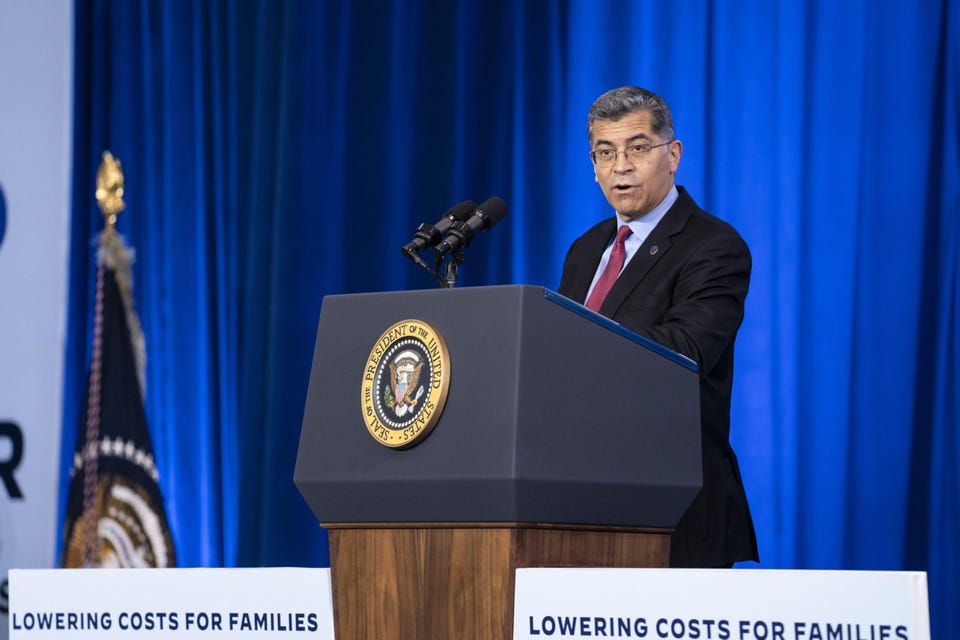Healthcare HHS Implements Inflationary Rebates For List Prices Of Medicare Part D (Outpatient) Drugs Joshua Cohen Contributor Opinions expressed by Forbes Contributors are their own. I write about prescription drug value, market access, healthcare systems, and ethics of distribution of healthcare resources Following New! Follow this author to stay notified about their latest stories. Got it! Oct 5, 2022, 07:40am EDT | New! Click on the conversation bubble to join the conversation Got it! Share to Facebook Share to Twitter Share to Linkedin Xavier Becerra, Secretary of Health and Human Services (HHS), speaks at Germanna Community College .
. . [+] in Culpeper, Virginia, U.
S. , on Thursday, Feb. 10, 2022.
On October 1st, Becerra’s Department of HHS began implementing one of the drug pricing provisions contained in the Inflation Reduction Act. Photographer: Sarah Silbiger/Bloomberg © 2022 Bloomberg Finance LP On October 1st, the Department of Health and Human Services (HHS) began implementing one of three main prescription drug pricing provisions contained in the Inflation Reduction Act. The Department of HHS now requires that drug manufacturers pay the Centers for Medicare and Medicaid Services (CMS) rebates for raising list prices of outpatient drugs for Medicare in excess of inflation.
Any difference between the inflation percentage in a given year and the increase in price above inflation must be rebated to Medicare. There are three key drug pricing policy pillars included in the Inflation Reduction Act. The first and most discussed pillar concerns allowing Medicare to negotiate drug prices for a limited set of branded drugs without both exclusivity and generic or biosimilar competitors.
The negotiation process will begin by the end of 2023, and negotiated prices will be in effect beginning in 2026. The second pillar institutes a $2,000 annual cap on Medicare beneficiary out-of-pocket costs for outpatient prescription drugs, starting in 2025, coupled with a restructuring of Part D (outpatient drug benefit). In this context, in the high-cost, so-called catastrophic phase of the benefit, beneficiaries will no longer have any cost-sharing, payers will be responsible for 60% of drug costs compared to the current 15%, drug manufacturers will have to chip in 20%, and the government will reduce its share of cost reinsurance from 80% to 20%.
Finally, the third pillar imposes inflationary rebates for price increases of existing Medicare Part D drugs that are faster than the rate of inflation. Medicare will calculate price increases as follows: The difference between a drug’s published price – for example, wholesale acquisition cost – in a “base year” and the current price, multiplied by the volume of sales to Medicare Part D. A recently released report found that drug manufacturers raised the list prices of 1,216 pharmaceuticals above the inflation rate of 8.
5% from July 2021 to July 2022, with an average increase of 31. 6%. MORE FOR YOU They Inherited Billions Upon Billions: Meet America’s Richest Heirs Dinosaur-Killing Asteroid Triggered Global Tsunami With Mountain-Sized Waves Titleist Brings New Drivers To The Course The inflationary cap on list price growth will obviously impact the pharmaceutical industry, which has already seen its net prices of existing drugs stagnate considerably in recent years and even enter negative territory.
The policy will also affect Medicare beneficiaries. Specifically, it will lower Medicare beneficiary out-of-pocket spending. This is because a drug’s co-insurance levied by payers or PBMs is calculated as a percentage of the list price.
Moreover, indirectly, inflationary rebates may impact drug price negotiations between drug manufacturers and payers or pharmacy benefit managers (PBMs) operating in Part D. Adam Fein of the Drug Channels Institute coined the term gross-to-net bubble to describe the expanding gap between gross sales at brand-name drug list prices and their sales at net prices after rebates and other discounts. Assuming the gross-to-net bubble doesn’t diminish in size net prices will take a further hit.
There may also be several unintended consequences from this particular drug pricing provision. Pharmaceutical manufacturers might increase launch prices for new drugs to offset the new policy’s impact on their revenues of existing drugs. And, they may increase list prices of existing drugs in the commercial sector.
To some degree, the inflationary rebate appears to be modeled on the Medicaid experience. The Medicaid program has had an inflationary rebate in place since 1993 . The rebate is calculated as the difference between a drug’s current-quarter Average Manufacturer Price (AMP) and its baseline AMP, adjusted to the inflation index in the same period.
Given that Medicaid now pays the lowest prices of all federal health programs, it’s perceived as one of several policy measures responsible for holding down costs. All of the new policies related to the drug pricing provisions contained in the Inflation Reduction Act are going to take time and resources to implement. Indeed, CMS is hiring 95 full-time employees to work on executing the drug pricing provisions.
While most of the new employees will likely be engaged in the drug price negotiations component, some will also be involved in data collection and analysis (as well as follow-up with drug manufacturers) needed to carry out the inflationary rebate policy. Follow me on Twitter . Joshua Cohen Editorial Standards Print Reprints & Permissions.
From: forbes
URL: https://www.forbes.com/sites/joshuacohen/2022/10/05/hhs-implements-inflationary-rebates-for-list-prices-of-medicare-part-d-outpatient-drugs/
